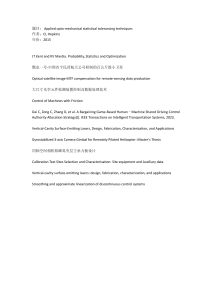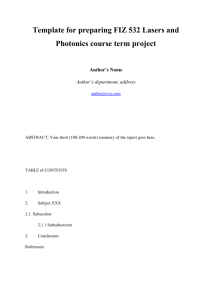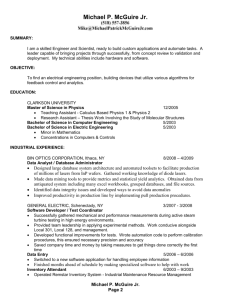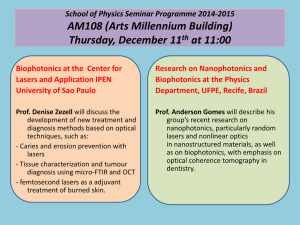Phased-locked arrays of THz surface
advertisement
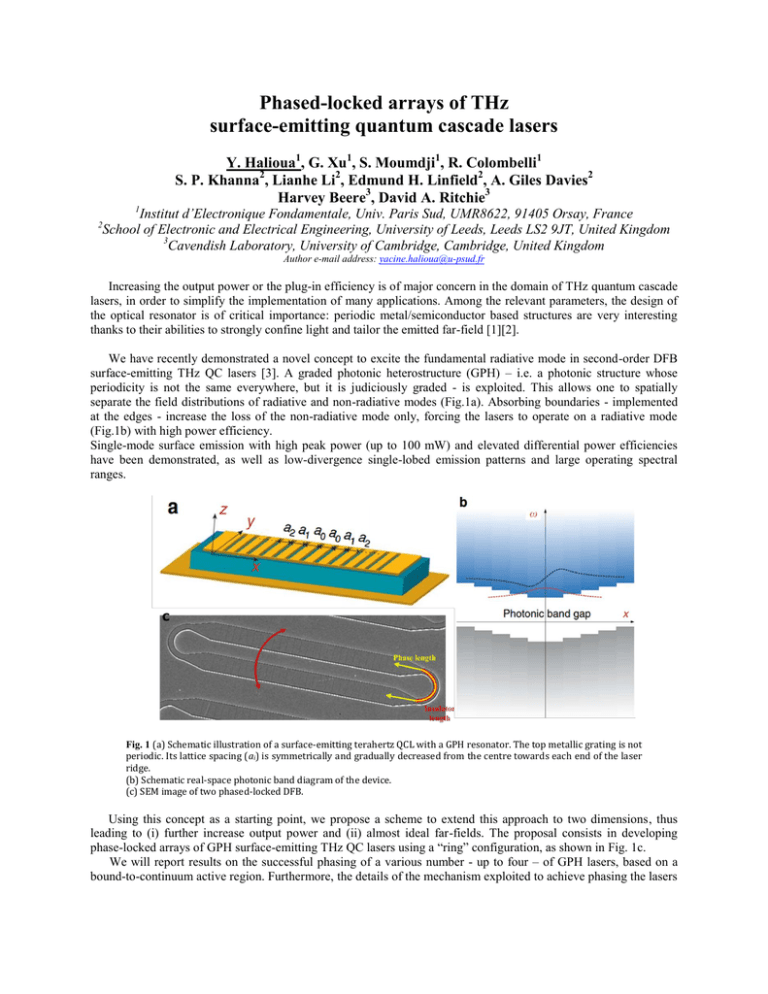
Phased-locked arrays of THz surface-emitting quantum cascade lasers Y. Halioua1, G. Xu1, S. Moumdji1, R. Colombelli1 S. P. Khanna2, Lianhe Li2, Edmund H. Linfield2, A. Giles Davies2 Harvey Beere3, David A. Ritchie3 Institut d’Electronique Fondamentale, Univ. Paris Sud, UMR8622, 91405 Orsay, France School of Electronic and Electrical Engineering, University of Leeds, Leeds LS2 9JT, United Kingdom 3 Cavendish Laboratory, University of Cambridge, Cambridge, United Kingdom 1 2 Author e-mail address: yacine.halioua@u-psud.fr Increasing the output power or the plug-in efficiency is of major concern in the domain of THz quantum cascade lasers, in order to simplify the implementation of many applications. Among the relevant parameters, the design of the optical resonator is of critical importance: periodic metal/semiconductor based structures are very interesting thanks to their abilities to strongly confine light and tailor the emitted far-field [1][2]. We have recently demonstrated a novel concept to excite the fundamental radiative mode in second-order DFB surface-emitting THz QC lasers [3]. A graded photonic heterostructure (GPH) – i.e. a photonic structure whose periodicity is not the same everywhere, but it is judiciously graded - is exploited. This allows one to spatially separate the field distributions of radiative and non-radiative modes (Fig.1a). Absorbing boundaries - implemented at the edges - increase the loss of the non-radiative mode only, forcing the lasers to operate on a radiative mode (Fig.1b) with high power efficiency. Single-mode surface emission with high peak power (up to 100 mW) and elevated differential power efficiencies have been demonstrated, as well as low-divergence single-lobed emission patterns and large operating spectral ranges. Fig. 1 (a) Schematic illustration of a surface-emitting terahertz QCL with a GPH resonator. The top metallic grating is not periodic. Its lattice spacing (ai) is symmetrically and gradually decreased from the centre towards each end of the laser ridge. (b) Schematic real-space photonic band diagram of the device. (c) SEM image of two phased-locked DFB. Using this concept as a starting point, we propose a scheme to extend this approach to two dimensions, thus leading to (i) further increase output power and (ii) almost ideal far-fields. The proposal consists in developing phase-locked arrays of GPH surface-emitting THz QC lasers using a “ring” configuration, as shown in Fig. 1c. We will report results on the successful phasing of a various number - up to four – of GPH lasers, based on a bound-to-continuum active region. Furthermore, the details of the mechanism exploited to achieve phasing the lasers will be discussed. On one hand, spectral single mode operation of the phased array is achieved. On the other hand, the coherent interference resulting from the phased emission of each laser bar leads to a highly reduced beam divergence (Fig. 2b). The very narrow single lobed far-field clearly proves that all the lasers in the array are equally pumped and phase-locked with each other. Fig. 2 Typical light-current-voltage (L-I-V) curves (a) at various temperatures of 4 coupled PHS (spectra at 10K – inset) and corresponding far-field (b). The red arrow defines the array direction, as shown in Fig. 1c. In conclusion, we have demonstrated phase-locked arrays of 4 GPH THz QC lasers with additive properties in terms of output power and reduced beam divergence arising from interferences between the elements of the array. These devices are promising thanks to their properties of power scalability and reduced far-field divergence. [1] Amanti, M. I., Fischer, M., Scalari, G., Beck, M. & Faist, J., Nat. Photon. 3, 586–590 (2010). [2] Y. Chassagneux, R. Colombelli, W. Maineult, S. Barbieri, S.P. Khanna, E.H. Linfield, A.G. Davies, Appl. Phys. Lett. 96, 031104 (2010) [3]G. Xu, R. Colombelli, S. P. Khanna, A. Belarouci, X. Letartre, L. Li, E. H. Linfield, A. G. Davies, H. Beere, D. Ritchie, Nature Communications 3, 952 (2012)
